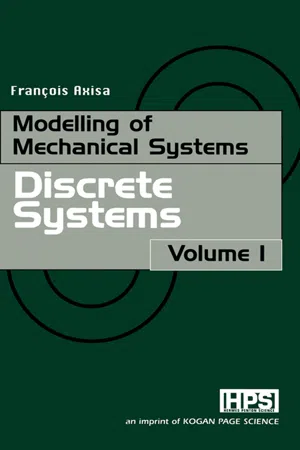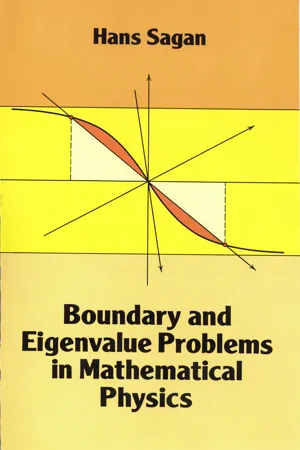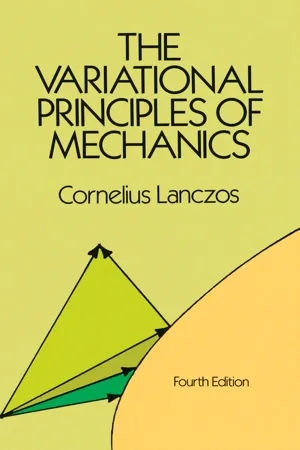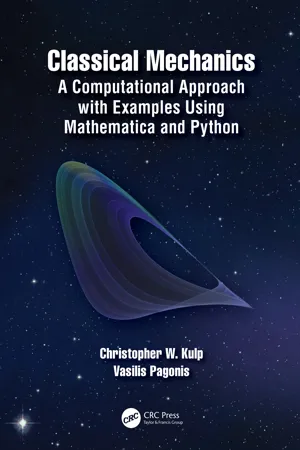Physics
Hamilton's Principle
Hamilton's Principle states that the path taken by a system between two points in time is such that the action integral is stationary. In other words, the actual path taken by a system is the one that minimizes the action integral. This principle is a fundamental concept in classical mechanics and is used to derive the equations of motion for a wide range of physical systems.
Written by Perlego with AI-assistance
Related key terms
Related key terms
1 of 4
Related key terms
1 of 3
6 Key excerpts on "Hamilton's Principle"
- Francois Axisa(Author)
- 2003(Publication Date)
- Butterworth-Heinemann(Publisher)
Chapter 3Hamilton’s principle and Lagrange’s equations of unconstrained systems
One of the most famous fundamental principles of theoretical physics is certainly the law of least action enunciated as a universal principle for the first time by Maupertuis (1746): “when a change occurs in nature, the quantity of action necessary for the change is the least possible”. Here, we shall introduce the exact formulation of this principle as made by Hamilton (1834), which states that the actual motion of a mechanical system between two arbitrarily fixed times t 1 , t 2 makes stationary the time integral over t 1 , t 2 of the extended Lagrangian of the system. Since this integral is suitably identified with the action of the Lagrangian, Hamilton’s principle is thus a principle of stationary action, historically understood as a principle of least action. It can be either postulated as a first principle, or derived from the principle of virtual work. One interesting point for applications in mechanics is that it allows one to introduce kinetic energy in a quite natural way through the Lagrangian. Furthermore, starting from it, Lagrange’s equations can be established by using a few mathematical procedures which are also of major interest in other problems in mechanics, which deal with continuous material systems provided with boundaries.3.1 Introduction
In the preceding chapter, Lagrange’s equations of discrete and unconstrained mechanical systems were formulated starting from the variational principle of virtual work. The latter may be considered as being differential in nature, because it deals with variations that are taken at a fixed time t .Here, we shall introduce another variational principle, where we consider the actual motion of the system between two arbitrarily fixed times t 1 , t 2 and small virtual variations about it, see Figure 3.1 . This is the principle of least action in its exact formulation given by Hamilton in 1834 and widely known as Hamilton’s principle,- eBook - ePub
- Robert Weinstock(Author)
- 2012(Publication Date)
- Dover Publications(Publisher)
lagrangian —as6-2. Hamilton’s Principle. Lagrange Equations of Motion(a ) Although Newton’s laws of motion are the most fundamental mathematical description of mechanical phenomena in general, it best suits the purposes of our study to assume the validity of Hamilton’s principle as the physical law which describes the motion of any system of the type considered in 6-1 above. The principle of Hamilton reads:The actual motion of a system whose lagrangian isis such as to render the (Hamilton’s) integralwhere t 1 and t 2 are two arbitrary instants of time , an extremum withrespect to continuously twice-differentiable functions q 1 (t ), q 2 (t ), …,qN(t )for which qi(t 1 )and qi(t 2 ) are prescribed for all i = 1, 2, …, N . We accept Hamilton’s principle as applicable to the motion of any conservative system.Although it is in some places stated that Hamilton’s principle may be used to replace Newton’s laws of motion as the fundamental starting point for mechanical systems possessing a lagrangian, it should be realized that Newton’s laws are implicitly employed in the preceding paragraphs in at least two ways: (i) The definition of mass resides in Newton’s third law. (ii) In the tacit assumption that our system of coordinates is fixed relative to an inertial frame of reference, we make use of Newton’s first law, by means of which an inertial frame is defined.(b ) With the result (57 ) of 3-8(a ) we conclude from Hamilton’s principle that the generalized coordinates describing the motion of a system of particles must satisfy the set of Euler-Lagrange equationsThe equations (8 ), Lagrange’s equations of motion, constitute a set of N simultaneous second-order differential equations, whose solution yields the functions q 1 (t ), q 2 (t ), …,qN(t ). The 2N constants involved in the general solution of (8 ) are evaluated when the initial (t = 0, for example) values of all theqiand (i = 1, 2, …, N ) are given. Once the initial state of the system is thus prescribed, its future motion is described in detail by the functions obtained through the solution of (8 - Hans Sagan(Author)
- 2012(Publication Date)
- Dover Publications(Publisher)
IHAMILTON’S PRINCIPLE AND THE THEORY OF THE FIRST VARIATION§1. VARIATIONAL PROBLEMS IN ONE INDEPENDENT VARIABLE1. Newton’s Equations of MotionLet us consider a field of force, which can be represented by the gradient of a point function U(x, y, z). (See AI.B3—Appendix , Part I, section B , subsection 3 .) We call such a field conservative because the law of conservation of energy is satisfied therein, (see problem I.1 ). We will assume that U(x, y, z) and its first- and second-order derivatives are continuous. The components of the force in the directions of the coordinate axes are thenwhere the subscripts x, y, z designate the x, y, and z components.If we consider a mass point of mass m moving within this field, it experiences at any point (x, y, z) a forceAccording to the fundamental principle of vectorial mechanics, the mass point m moves in a pathwhich is defined by the condition that the external force exerted by the field at any point is equal to the inertial force m(d2 s/dt2 ) exerted by the mass point. This gives Newton’s well-known equations of motion- eBook - ePub
Universe Dynamics
The Least Action Principle and Lagrange's Equations
- Jacques Vanier, Cipriana Tomescu (Mandache)(Authors)
- 2019(Publication Date)
- CRC Press(Publisher)
It is a question that has intrigued human beings since they first started reflecting on the exact nature of that physical universe we inhabit. No general answers to that profound question covering the entire field of physics have been found. There are many aspects of the behavior of objects in the universe that lead us to believe that the universe may evolve by means of a basic principle that is more general than the specific laws enunciated above. For example, it looks very much that in general nature favors situations of minimum energy. Objects falls on the ground where energy is lower. In searching for minimum energy, nature appears also to look for equilibrium or stationarity. Another observation is that the universe appears to behave in a manner that tends towards simplicity. For example, paths of objects thrown in the air above the earth’s surface seem to be rather regular and uniform. Light travels in a straight line and not in a complicated path; it is reflected from surfaces with a behavior that has been put under the form of rather simple rules. The conservation principles introduced earlier appear to have some origin that deserve deeper reflection than just being the result of assumptions and the elementary analysis that we made. All these considerations lead us to believe that nature is driven by some basic law or principle that just needs to be discovered.Such a principle was proposed some time ago following the deep thinking of physicists that followed Newton, such as Bernoulli, Euler, Lagrange, Hamilton and several others. The principle in question is called principle of least action . We will see that a study of that principle leads to differential equations called Lagrange’s equations , which essentially replaces the dynamical equations of motion and conservation laws that we have introduced above. When that principle is applied properly, it also leads to basic laws governing the evolution of the universe as regards its general behavior as well as some of its details. In fact, the approach using that principle is rather universal and appears to regulate the dynamics of material objects and entities such as fields within the whole of physics at both the large scale as well as at the atomic level.Before going into the mathematical description of that principle, we need, however, to familiarize ourselves with an interesting mathematical tool called the calculus of variations - eBook - ePub
- Cornelius Lanczos(Author)
- 2012(Publication Date)
- Dover Publications(Publisher)
t as a function of τ. This last equation is the expression of the energy theorem and no part of the variation problem. However, it completes the variation problem by determining how the motion occurs in time.Jacobi’s principle is a fundamental principle of mechanics. If we restrict ourselves to the case of a single particle, the line element becomes identical with the line-element of ordinary three-dimensional space in arbitrary curvilinear coordinates. Jacobi’s principle then presents a remarkable analogy with Fermat’s principle of least time in optics which determines the optical path by minimizing the integralwhere n is the refractive index, which may change from point to point, thus behaving in a manner similar to the quantity √2(E — V). Maupertuis claimed that the phenomena of nature can be derived by minimizing a certain quantity which he called “action”—a quantity which, if suitably formulated, coincides with Jacobi’s integral (56.12 )—and he tried to show that the law of the refraction of light is deducible from the principle of least action as well as from Fermat’s principle of least time. He thus pointed to that remarkable analogy between optical and mechanical phenomena which was observed much earlier by John Bernoulli and which was later fully developed in Hamilton’s ingenious optico-mechanical theory. This analogy played a fundamental role in the development of modern wave-mechanics.The link in this analogy is Jacobi’s principle on the one hand and Fermat’s principle on the other. The analogy does not go beyond the path described by a moving point in mechanics and by a light ray in optics. How the motion occurs in time is entirely different in the mechanical and in the optical case (cf.chap. VIII, section 7 ).Jacobi criticized Lagrange’s treatment of the “principle of least action,” pointing out the importance of varying between definite limits, which is not possible if the time is used as the independent variable. In that case the upper limit of the action integral has to be varied in a definite manner, in order to satisfy the conservation of energy throughout the actual and the varied path. Nevertheless, the procedure of Euler and Lagrange in their formulation of the principle of least action is, when properly understood, entirely correct, and their principle is only formally different from Jacobi’s principle. Jacobi’s principle, as we have seen above, can be conceived as the result of the following steps. - eBook - ePub
Classical Mechanics
A Computational Approach with Examples Using Mathematica and Python
- Christopher W. Kulp, Vasilis Pagonis(Authors)
- 2020(Publication Date)
- CRC Press(Publisher)
t stationary. Therefore, the Euler-Lagrange equation,dd t(−)∂ L∂q ˙= 0∂ L∂ q(8.2.6) will produce the equation of motion. Inserting (8.2.5 ) into (8.2.6 ) gives the simple plane pendulum equation,q ¨+g ℓsin q = 0(8.2.7) 8.3Hamilton’s principleNow that we have developed an understanding of generalized coordinates, it is time that we justify using the Euler-Lagrange equations to derive a system’s equations of motion. This justification was done by Irish mathematician, Sir William Rowan Hamilton (1805–1865), in papers published in 1834 [Hamilton (1834)] and 1835 [Hamilton (1835)]. Hamilton’s Principle states:Hamilton’s PrincipleThe path taken by a particle from the point r1 to the point r2 during the time interval t1 to t2 is the one that makes the action integralS =stationary.∫L d tt 1t 2Hamilton’s principle is a cornerstone not just of classical physics, but also of quantum physics. From Chapter 7 , we know that the condition for S to be stationary isThe Euler-Lagrange Equationdd t(−)∂ L∂q ˙j= 0∂ L∂q j(8.3.1) where qjis the jth generalized coordinate, j = 1, 2, …, s, and s is the number of degrees of freedom in the system.How can we be certain that Hamilton’s principle produces the actual path that the particle takes? We will demonstrate this using a system with one degree of freedom, but is easily generalized to s degrees of freedom. We will follow the argument used to derive the Euler equation in Chapter 7 , and therefore we want to find a function q(t) that makes the action integral,S =∫Lt 1t 2( q ,d tq ˙)(8.3.2) stationary. Following the argument from Chapter 7 , we will perturb q(t) using a function η(t), which is zero at the limits of integration, as shown in Figure 8.2 . The function Q(t) is the perturbation of q(t) and the perturbation has a size a
Index pages curate the most relevant extracts from our library of academic textbooks. They’ve been created using an in-house natural language model (NLM), each adding context and meaning to key research topics.
Explore more topic indexes
Explore more topic indexes
1 of 6
Explore more topic indexes
1 of 4





